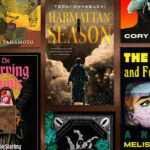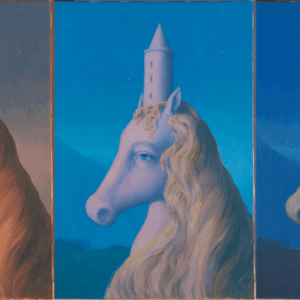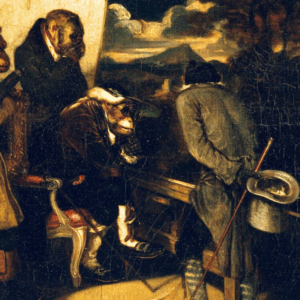
Connecting the Dots: On Creating Fiction from Facts
Beth Kephart Considers the Craft of Bringing a Fiction Writer’s Eye to Real Lives
I was a mud on the knees girl, a tadpole seeker, a Pogo Sticker, a kid who took off at every speed—by foot, in roller-skates, on whatever bike that fit me. Speed was my thing.
But hand me a dot-to-dot, and I went still. I took my crayons to the puzzle pages and drew the lines that drew the thing that the puzzle makers had persuaded me to see. In 1909, The Birmingham age-herald printed “Black Dot Puzzle for Wee Ones,” inviting kids to find the boy among the dots; the game was a sensation. By the time I was the middle child of suburban parents, decades later, connect the dots, follow the dots, find the answer was a proliferated, placating thing. Perhaps because I took such pleasure from those crusty, off-white, almost empty then vibrantly inhabited pages, I grew up to be a writer craving the same sensation—that mysterious scattering of specks and flecks, jabs and jots that suggest and then make possible a single something.
In the case of Tomorrow Will Bring Sunday’s News: A Philadelphia Story, my new novel that is also partly memoir, the specks and flecks were the few known facts of my grandmother’s life: Her favorite song was “Among My Souvenirs.” She lived, as a child, in South Philadelphia and as a married woman in the city’s southwest. She was one of many children. She was sixteen in 1918. She worked (though I do not know precisely when) at Fleisher’s Yarn, a brand-new factory at 26th and Reed. Her wedding dress was not white. She liked pansies and hats.
If I connected the dots, what story would emerge? Who would my grandmother turn out to be? And what would serve as the graphite, ink, wax, or brush that filled the spaces in between? Removed the gaps? Suggested a form?
I chose history, landscape, and weather as my tools. I chose contemporaneous maps and photographs and musical recordings, newspaper stories and advertisements, brand names, store names, magazines (Textile World!), posters (American Red Cross!), legislation (The Sedition Act!), architectural blueprints or descriptions. I connected my jabs and jots with the facts I could find—not to prove that I had done my research, but to live within the time. To draw an edge around the story I hoped to tell. A story that could contain itself. A story that began to sound like this:
Get up, she thinks. Get up, and stomp your feet. She hears the sound of the spotted mules and the wagons out on Twenty-third and the silence in between. No Model Ts, no Chevrolet Ds, no Overland Model 90Bs, no automobiles in the thick drifts of snow on the streets.
And this:
But down at Twenty-sixth and Reed, a family of proprietor-philanthropists named Fleisher is raising up from crumpled ground a brand-new building, the largest yarn and braid factory in the world—a consolidating enterprise in the company’s fiftieth year. Peggy has watched the building grow. She has stood at a safe distance from the spectacle beside the boy as the concrete has been poured, the bars put up, the red brick and the light brick layered in, tasteful and ornamental.
So that I needed the flecks, and I needed the tools that drew the lines, but I also needed—writers also need—the hues and shades, the color that lives inside the boundaries we’ve summoned, by which I mean mood, tone, attitude, style, sensibility, theme. Sibilance. Percussion. Short and long, compression and expansion, white space, pause, right branching, left branching, the period or the dash, the sentence broken into parts because in syncopating sympathy with the rhythm of the moment:
the clack,
the clack,
of the knitting as Peggy walks. The sound of the women on the stoops, on the corners, in the parks, saving the ones they love with yarn, the sons, the husbands, the brothers, the boys. The million-mile miles of wooly and wild, as if the yarn streamers behind as she walks, as if she were the Grand Marshal of the war-effort parade, as if the boy with the space between his teeth will be coming toward her, running toward her, if she just walks far enough.
I was, at last, inside Peggy’s world. I could hear those needles clacking.
Transmutation—bridging the known to the unknown, the remembered to the imagined, the truth to the embellished—is a writer’s privilege, a writer’s realm. It is a lesson we absorb from Willa Cather, who, as Hermoine Lee wrote in her 1989 biography of the writer, Double Lives, is “an historian; her imagination works through memory, distance, and loss. She translates her landscapes, and the figures in them, into landscapes of the mind.” It is a method quietly laid out by Eudora Welty in her autobiography, One Writer’s Beginnings, where she speaks of the fictional eye [that] sees in, through, and around what is really there.” It is a practice suggested by Ocean Vuong who, in the text accompanying his recent New York Times photo essay, “My Brother’s Keeper,” writes: “I ask the ghosts to show us what to make of their lives.”
And it is a craft, finally and again, whose roots can be found, I believe, in that childhood pastime, the dot-to-dot—first the flecks, next the lines, do not forget the color.
Beth Kephart
Beth Kephart is a teacher of memoir, the co-founder of Juncture Workshops, and a book artist. She is the award-winning author of more than three dozen books in multiple genres, including Wife | Daughter | Self: A Memoir in Essays and We Are the Words: The Memoir Master Class. Her book Flow: The Life and Times of Philadelphia’s Schuylkill River (Temple) has become a regional classic. Visit her online at bethkephartbooks.com and etsy.com/shop/BINDbyBIND.



















